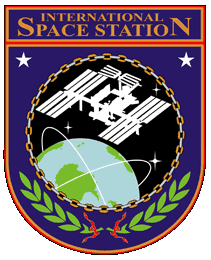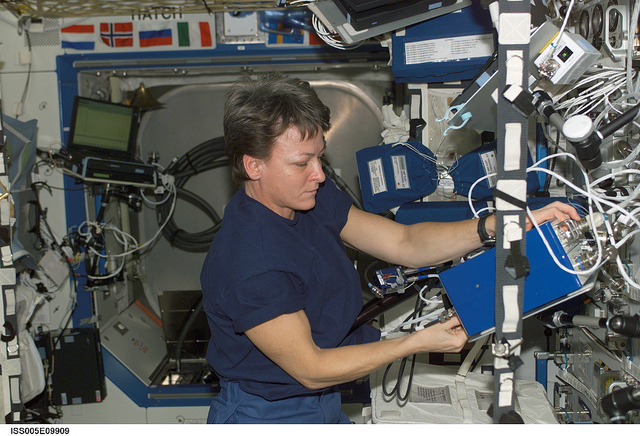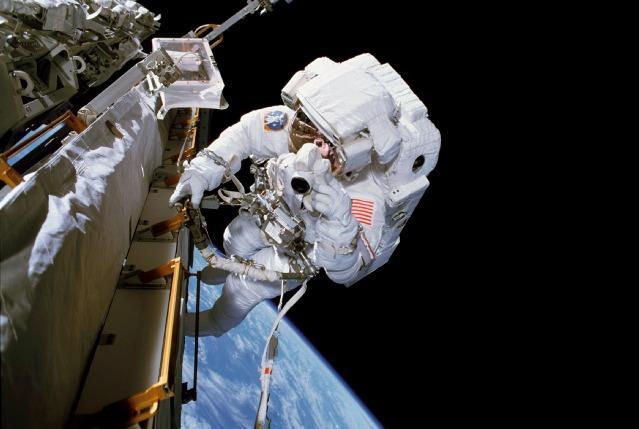International Space Station Research

The UCSD Physiology/NASA lab conducted some exciting research on the International Space Station, studying expedition crews three through six over a period of about two years. The Pulmonary Function in Flight (PuFF) experiment was part of the U.S. Lab's Human Research Facility, a laboratory module which contains hardware available for researchers to study the effects of microgravity on the human body. HRF Rack 1 was launched in March of 2001 in the Leonardo Multi-Purpose Logistics Module, and placed in the US Laboratory.
Now able to study crews for more than the 2-3 week length of a Space Shuttle mission as had been done previously by the UCSD team, the PuFF experiment studied the effects of long-duration exposure to microgravity on the lung, with the crew residencies ranging from 130 - 196 days on orbit. The effect of spacewalks on the lung due the reduced pressure of the Extra-Vehicular Activity (EVA) suits, was also investigated for the first time. Changes in lung function due to long stays on-orbit, either from removal of gravity itself or from exposure to contaminants in the closed spacecraft environment, could adversely affect crew health. Changes in blood flow associated with EVAs could have indicated an increased risk of decompression sickness, commonly known as the bends, which the UCSD team was glad to report was not seen in any of the crewmembers studied after spacewalks.

Unlike the ALFE equipment flown on the Space Shuttle, the volume constraints of the shared Human Research Facility rack meant that no test gas mixtures could be flown aboard the ISS. Despite this limitation of having only cabin air to breathe, five different pulmonary function tests were included in the test sequence that the crew performed. Lung volumes, maximum inspiratory and expiratory flows, respiratory muscle strength, resting gas exchange, and numerous indices of the uniformity of lung function were able to be investigated. Using these tests the UCSD group was able to look for indicators that the crew's lung function and ability to exchange gases might have been compromised by their long stay in microgravity. A more comprehensive set of tests including ones using test gas mixtures was done as part of the crew's preflight and postflight test sessions.
Like with the ALFE hardware flown on the Shuttle, the ISS crewmembers performed all of the setup and calibration of the PuFF equipment themselves, as it was never a guarantee that there would be communication with the ground during this time. A computer-based training and procedures program put together by the UCSD team guided them through the steps, with pictures and more information available if they needed it. The data was saved on the HRF's laptop computer, and downlinked to UCSD on the ground when an opportunity was next available.

All ten crewmembers who participated in the PuFF experiment performed the tests before flight, in flight, and after flight and acted as their own controls. For the investigation of the effect of EVA on the lung, a test session was conducted within one week before and again as soon as was possible after the EVA, which typically was the following day.
Results from the research show that, unlike many other organ systems in the human body, lung function returns to normal almost immediately after long-duration exposure to microgravity. The most important, and somewhat surprising, aspect is the almost complete absence of a change in lung function before and after spending 4 - 6 months in low Earth orbit, despite the fact that the lung is highly sensitive to gravity. The magnitude of the observed changes in the ten subjects were so small that the conclusions, of no lasting effect of microgravity on lung function, would hold even if the study had included a greater sampling group. Some very tiny and subtle changes in lung function that persist soon after landing are possibly due to a reduction in circulating blood volume and alterations in lung fluid balance, and are of little, if any, physiological consequence. This finding is significant and encouraging since it proposes that lung function is not a concern under the normal oxygen and pressure environment such as that inside the ISS (Prisk 2005, 2006, 2008).
